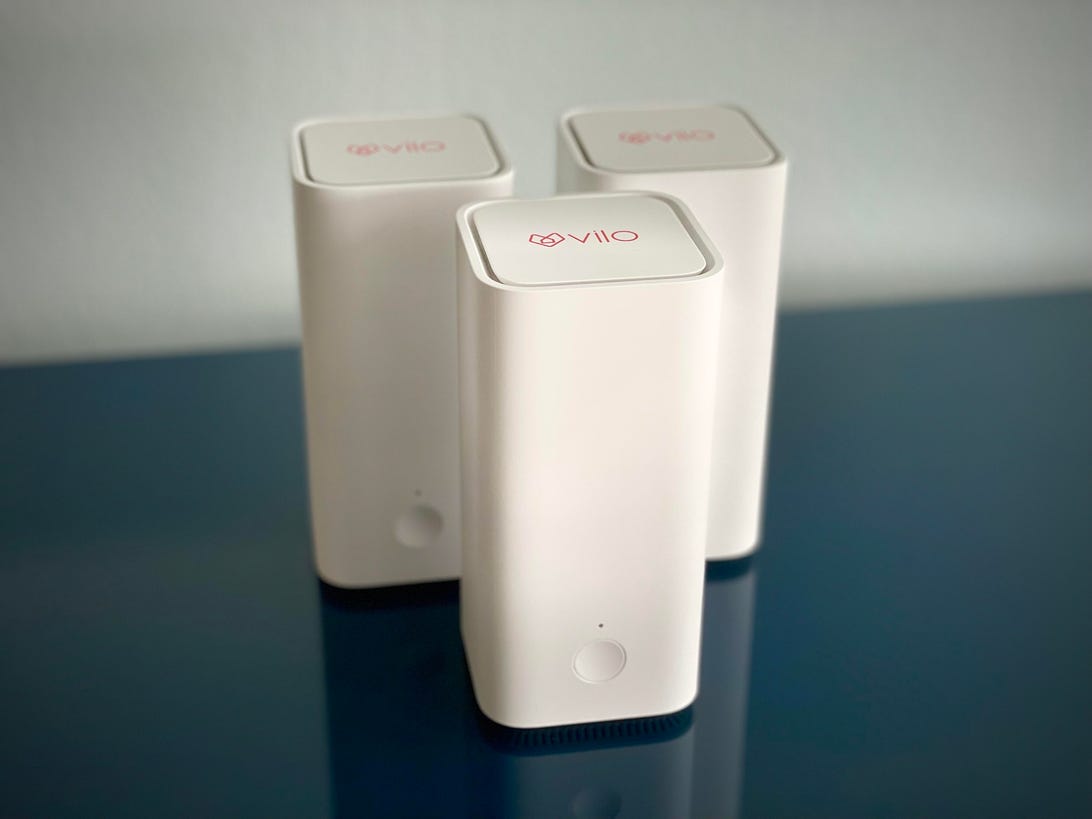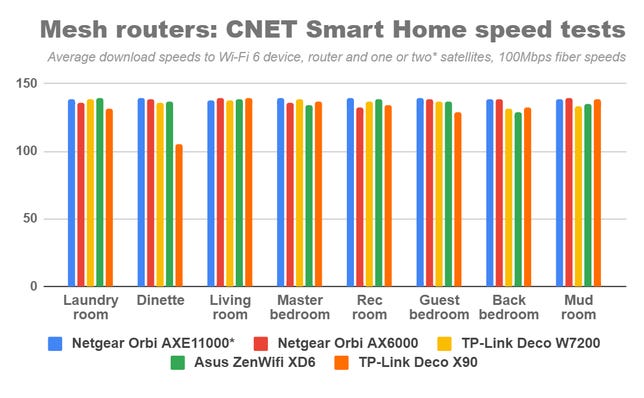Best Mesh Routers for 2022 – CNET [CNET]
The pandemic led millions of us to work and learn from home, not to mention all of the gaming online with friends and calling loved ones for regular video chats. As a result, the average home’s internet use has surged over the past few years — and that uptick in traffic has pushed a lot of home networks to their limit. If you’ve been struggling to stay connected at top speed, it might be time for a home networking upgrade.
One of the best moves for many households is to upgrade from a router to a mesh system. With multiple devices spread throughout your home, a good mesh router is like a team of routers that can relay your wireless traffic back to the modem better than a traditional router, especially when you’re connecting at range. And there are lots of new, next-gen options on the market, so it’s a prime time to make the switch.
With the right system quarterbacking your connection, you could enjoy total wireless coverage and speeds that reach your network’s capacity throughout the majority of your home, if not the entirety of it. Better yet, you won’t have to juggle your connection between your main network and a separate extension network like with a lot of standalone range extenders. Given that range extension is already baked into the system, the mesh router will automatically route your connection accordingly within a single, unified network.
Some of the best mesh routers we’ve tested include systems from Eero, which popularized mesh networking before being bought by Amazon in 2019, as well as the latest setups from TP-Link Deco, Asus ZenWifi, Netgear Orbi and Google Nest. Mesh systems regularly sold for as much as $500 a few years ago, but now these manufacturers offer multipoint mesh router systems — including the main router and the additional satellite extenders — that cost less than $300, or even below $200. Though we’d recommend aiming a bit higher, you can even find basic, entry-level mesh systems for as little as $20 per device.
We’ve still got lots of routers and mesh systems we’d like to try out — including a growing number that use Wi-Fi 6 technology, promising better performance and faster speeds. More mesh routers that support Wi-Fi 6E, which means they can access a newly unlocked mass of fresh bandwidth in the 6GHz band, should continue to arrive throughout 2022, but it’s probably still too early to invest in a system like that (and believe me, they won’t come cheap).
Expect regular updates to this post as new Wi-Fi mesh routers like those make it to market. For now, here are our picks for the top-tested systems you should be considering first if you’re buying now.
CNET editors pick the products and services we write about based on editorial merit. When you buy through our links, we may get a commission. Read more about how we test mesh routers.
After running countless speed tests in multiple spots throughout my home, where I have fiber internet with upload and download speeds of 300Mbps, I average the results together to get these aggregate speed ratings for each mesh router I test. Here’s the leaderboard as it currently stands. (Routers with stars were tested with a Wi-Fi 5 client device, before we were using Wi-Fi 6 devices for our at-home tests. Routers without stars were tested with a Wi-Fi 6 client device.)
Ry Crist/CNETThe biggest names that are still waiting for Wi-Fi 6 speed test data are the Nest Wifi mesh router and the Asus ZenWifi XT8, both of which performed well when I tested them with my old Wi-Fi 5 laptop. The latter is a tri-band router with support for Wi-Fi 6, so it would likely be a spot or two higher on that leaderboard (and potentially higher than the dual-band ZenWifi XD6) if we had tested it with a Wi-Fi 6 device.
I’ll update this post when I’m able to add those results, and I’ll also continue to run tests on both types of client devices in order to get a good sense of how well these routers perform with both current- and previous-gen hardware. You can check out my full reviews for more information on that breakdown.
The short version is that newer client devices that support Wi-Fi 6 will typically be able to hit sustained speeds that are noticeably faster than what you’ll get with older, Wi-Fi 5 devices — but previous-gen devices like those can still benefit from a mesh router that supports Wi-Fi 6.
Specifically, my data shows better performance at range, with speeds that didn’t dip as much in the back of my house. With the top-performing Netgear Orbi AX6000 system and others like it, speeds hardly dipped at all. Connecting my old laptop near the satellite in that master bedroom and back bathroom was almost as good as connecting near the router itself in the living room.
That likely stems from the fact that the router and the satellite are able to use Wi-Fi 6 to relay signals back and forth more efficiently and at faster speeds. The Orbi AX6000’s tri-band design does some heavy lifting here, too, as that allows the system to dedicate an entire 5GHz band to the backhaul transmissions between the router and satellite.
Just be aware that adding an extra band to the mix really brings the price up. The Asus ZenWifi XT8 and Eero Pro 6 each cost about $400 or so for a two-pack, while the Linksys Velop MX10, AmpliFi Alien, Arris Surfboard Max Pro and Netgear Orbi AX6000 systems each cost about $600 or $700 for a two-pack. Meanwhile, our top pick, the TP-Link Deco W7200, only costs $229 for a two-pack.
If you live in a large home and need more than one satellite extender, the Eero Pro 6 is worth considering. At $599 for a three-pack, it’s expensive, but it still costs less than most other tri-band three-packs with support for Wi-Fi 6.

The Vilo mesh router is the slowest I’ve ever tested, but it’s functional, and it only costs $20 per device, plus shipping.
Ry Crist/CNETIf you’re living with a slow ISP connection and you don’t need Wi-Fi 6 or a fancy tri-band build, then there’s nothing wrong with skipping those upgrades and going with something simpler in order to save some money. I’ve tested a number of bargain picks like that — among them, the AC1200 version of Netgear Orbi, currently available in a three-pack for $100, is my top recommendation, with the right balance of performance and value. If you really want to get dirt cheap, you could opt for a system like Vilo, which costs just $20 per device, plus shipping. It’s the slowest mesh router I’ve ever tested, which wasn’t surprising, but it was still functional and able to maintain average download speeds above 100Mbps in that back bathroom of mine.

We’ve resumed our mesh router tests at the CNET Smart Home, starting with some of our top-performing systems — all were able to maintain strong average speeds throughout the entire place. Note the strong, across-the-board jump in upload speeds from the Wi-Fi 5 client to the Wi-Fi 6 client.
Ry Crist/CNETCNET Smart Home tests
After suspending most of our tests from the lab and the CNET Smart Home during 2020 and 2021, we’re picking up where we left off in 2022. For starters, I’m running an entire, separate set of tests for every mesh router I review at the CNET Smart Home, a 5,400 square-foot multistory home located in the rural outskirts of Louisville, where we’ve got a fiber internet connection with upload and download speeds of up to 100Mbps.
For those tests, I run multiple rounds of speed tests across eight rooms: Four on the main floor, where the router lives, and four in the basement, where I place a satellite extender. I complete this process three separate times — once to an Apple iPad Air 2 from 2015 that uses Wi-Fi 5, again with a Lenovo ThinkPad laptop that supports Wi-Fi 6, and a third round of tests to a Samsung Galaxy S21 that uses Wi-Fi 6E to connect over the 6GHz band. Routers that don’t support Wi-Fi 6E will still work with devices like that, but they’ll treat them like regular Wi-Fi 6 devices, meaning that the 6GHz band won’t be in play.
Here’s a peek at some of my speed test data for the standard Eero 6 mesh router. In the top batch of tests, I started my connection close to the router and moved towards the back of the house. In the bottom tests, I connected in the back of the house and moved closer to the router. The results were wildly inconsistent, which wasn’t an issue I found with the Eero Pro 6.
Ry Crist/CNETSpeaking of the standard Eero 6 system, it was a disappointment when I tested it out, with weak, inconsistent speeds between my various rounds of testing. Specifically, I saw a night-and-day difference in my speeds depending on whether or not I started my connection in the same room as the router. If I connected from afar, the system would keep my connection on the slower 2.4GHz band even after moving closer to the router. The issue is much, much less severe with the new Eero 6 Plus, which scored much higher in my tests, so go with that newer system instead.
Among the other routers I’d pass on are fancier models that actually finished pretty high on that leaderboard. For instance, I was impressed with the Asus ZenWifi XD6, a dual-band mesh router that managed to keep up with the tri-band models I’ve tested, but the upload speeds were a bit weak, and with a price tag that’s pretty close to what you’d pay for the fancier, tri-band ZenWifi system, the value isn’t especially strong. I’ve seen it marked down closer to $300 for a two-pack, which is pretty tempting, but I can’t quite recommend it at full price.
The Arris Surfboard Max AX6600 was another strong performer that I’d skip. It aced my Wi-Fi 6 tests, finishing with the third-best average download speeds in my home of any system I’ve tested, but performance was much less consistent with Wi-Fi 5 devices, which makes it hard to recommend at its full price of $400 for a two-pack.

It isn’t a top performer or a value pick, but the Amplifi Alien is a great-looking Wi-Fi 6 mesh router that lets you create a VPN-style connection to your home network when you’re traveling, which is a nice, unique feature.
Chris Monroe/CNETSetup, security, features and other considerations
Performance and value are probably the first things you’ll look for as you shop for a mesh router, but there are other factors worth taking into consideration as well. Take features, for instance. Mesh routers typically don’t come with very many unique bells and whistles, but there are some standouts. The Amplifi Alien mesh router from Ubiquiti is a good example — apart from a unique-looking build, it features touchscreen controls on the front of each device, along with a feature called Teleport that lets you establish a VPN-style connection to your home network when you’re traveling. That’s a useful trick that lets you leverage your home network’s security capabilities when you’re connecting to a public Wi-Fi network.
Speaking of security, if you’re buying a new router, then it’s worth looking for one that supports the latest encryption standards. Most of the new models released in the last year or two support WPA3 for stronger defense against things like brute-force hacking attempts — I’d want a model like that if it were me making the upgrade.
These radar graphs show you the latency across all of my speed tests for each router I test. You’re looking for results with fewer spikes that stick close to the center. Among these four top picks, the Eero Pro 6 (blue) performed the best.
Ry Crist/CNETWe’re also planning to resume testing signal strength at the 5,800-square-foot CNET Smart Home this year after putting those tests on hold during the pandemic. Using NetSpot software, we’re able to make a map showing the signal strength of each device in the mesh, which gives you a good indication of the system’s range and the quality of the connection.
In 2022, we’ll resume our signal strength tests at the 5,800-square-foot CNET Smart Home. In a large home like that, adding a third device to the mesh is your best bet for a better connection at range.
Steve Conaway/CNETIt’s worth pointing out that those maps show you the aggregate signal strength of each system throughout the house and not their actual download speeds. That said, better signal strength means better wireless speeds. My partner-in-testing Steve Conaway summed it up thusly: “Yellow means you’re in heaven, green means good enough and blue means WTF.”
The main takeaway from those tests is that you’ll want to prioritize getting a system with more than one extender if you live in a home as large as our Smart Home — in most cases, those additional extenders will make a much more noticeable impact in the strength of your connection at range than an upgrade to Wi-Fi 6 or a tri-band design will.
What about Wi-Fi 6E?
Wi-Fi 6E is a new designation for Wi-Fi 6 devices that are equipped to send transmissions in the 6GHz band, which is something routers couldn’t do until recently, after the Federal Communications Commission voted to open that band for unlicensed use. The 6GHz band offers more than twice as much bandwidth as the 5GHz band and there aren’t any older-generation Wi-Fi devices using it, so the pitch is that it’s sort of like an exclusive, multilane highway for your internet traffic.

The newest Linksys Velop mesh router supports Wi-Fi 6E, which means it can transmit on the 6GHz band.
LinksysThere are already a handful of routers that support Wi-Fi 6E available for purchase. Among them is the Linksys Velop Atlas Max 6E mesh system, which — at $900 for a two-pack, or $1,200 for a three-pack — is one of the most expensive mesh routers you can currently buy.
Wi-Fi 6E routers like that are certainly impressive pieces of hardware, but I won’t be recommending that anybody buy one this year. Remember, the only devices that can connect over 6GHz are other Wi-Fi 6E devices and, aside from the Samsung Galaxy S21 and a handful of others, there are hardly any of those on the market yet.
Even if you do own a device like that, you’ll likely be better off on the 5GHz band than on 6GHz. Seriously. In most cases, both will top out at whatever max speeds you’re paying for from your internet provider, but the 6GHz band has noticeably weaker range than 5GHz.
Just take a look below at my at-home test-data for that Atlas Max setup. I ran a full set of speed tests for each of the router’s three bands using a Galaxy S21, with the main router hooked up in my living room and a single extender placed in my master bedroom. The router performed well — but it’s the green 5GHz band that performed the best. The 6GHz band, shown in yellow, saw its speeds dip as I moved away from the main router. They rebounded a bit as I neared the extender, but the speeds on 5GHz were faster overall and I didn’t notice any appreciable difference between the bands in terms of latency, either.
- Oscars 2022: Start Time, How to Watch or Stream the Awards Online – CNET [CNET]
- Halo Series Episode 1 Review – Unmasking The Pilot’s Highs and Lows [Game Informer]

![best-mesh-routers-for-2022-–-cnet-[cnet]](https://i0.wp.com/upmytech.com/wp-content/uploads/2022/03/57239-best-mesh-routers-for-2022-cnet-cnet.jpg?resize=800%2C445&ssl=1)




![will-iphone-12-have-touch-id-so-we-can-unlock-our-phones-with-masks-on?-probably-not-–-cnet-[cnet]](https://i0.wp.com/upmytech.com/wp-content/uploads/2020/10/12279/will-iphone-12-have-touch-id-so-we-can-unlock-our-phones-with-masks-on-probably-not-cnet-cnet.jpg?resize=300%2C167&ssl=1)
![mozilla-winds-down-deepspeech-development,-announces-grant-program-[venturebeat]](https://i0.wp.com/upmytech.com/wp-content/uploads/2021/04/27315-mozilla-winds-down-deepspeech-development-announces-grant-program-venturebeat.png?resize=390%2C205&ssl=1)
![cisos:-embrace-a-common-business-language-to-report-on-cybersecurity-[venturebeat]](https://i0.wp.com/upmytech.com/wp-content/uploads/2022/07/79022-cisos-embrace-a-common-business-language-to-report-on-cybersecurity-venturebeat.jpg?resize=390%2C205&ssl=1)